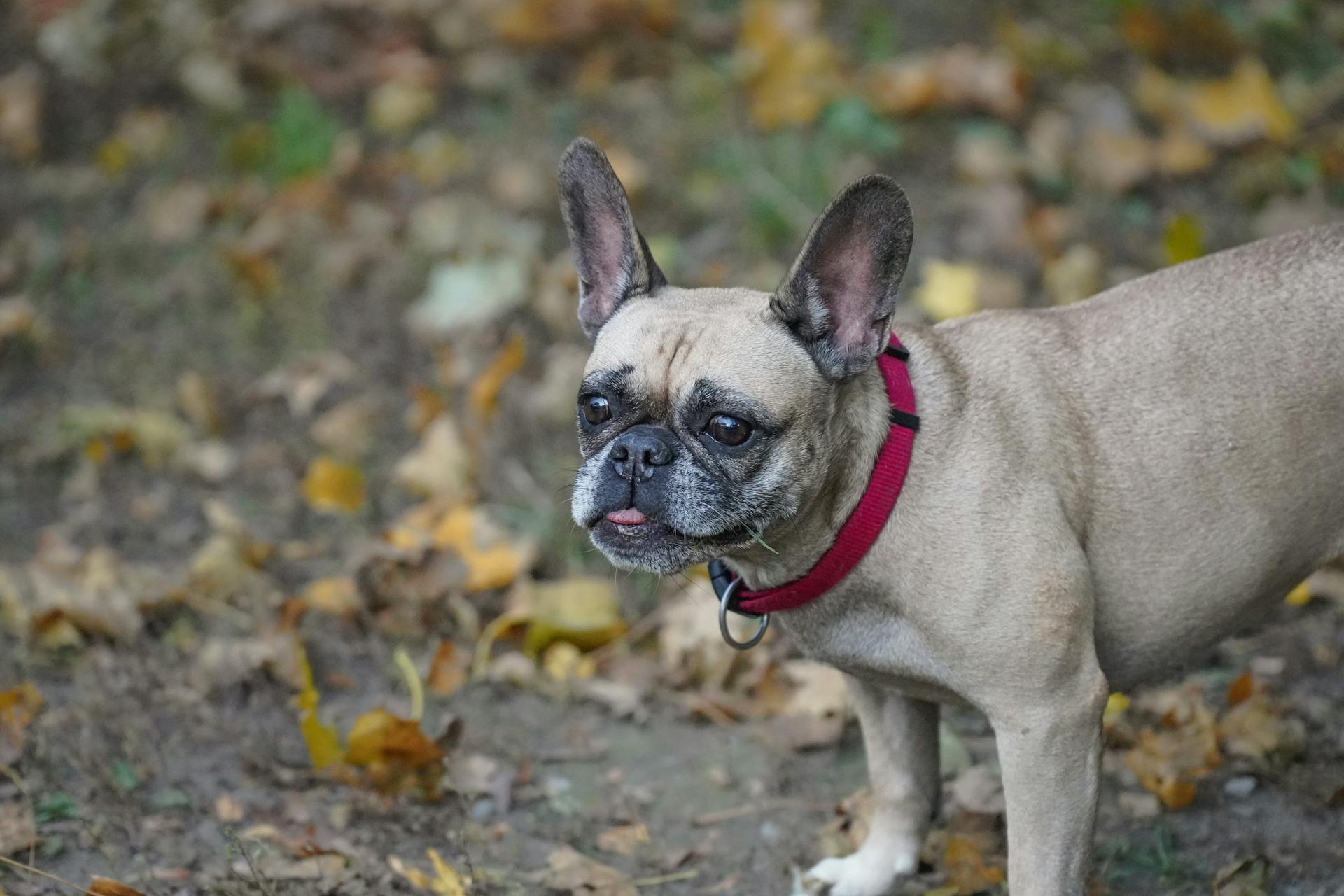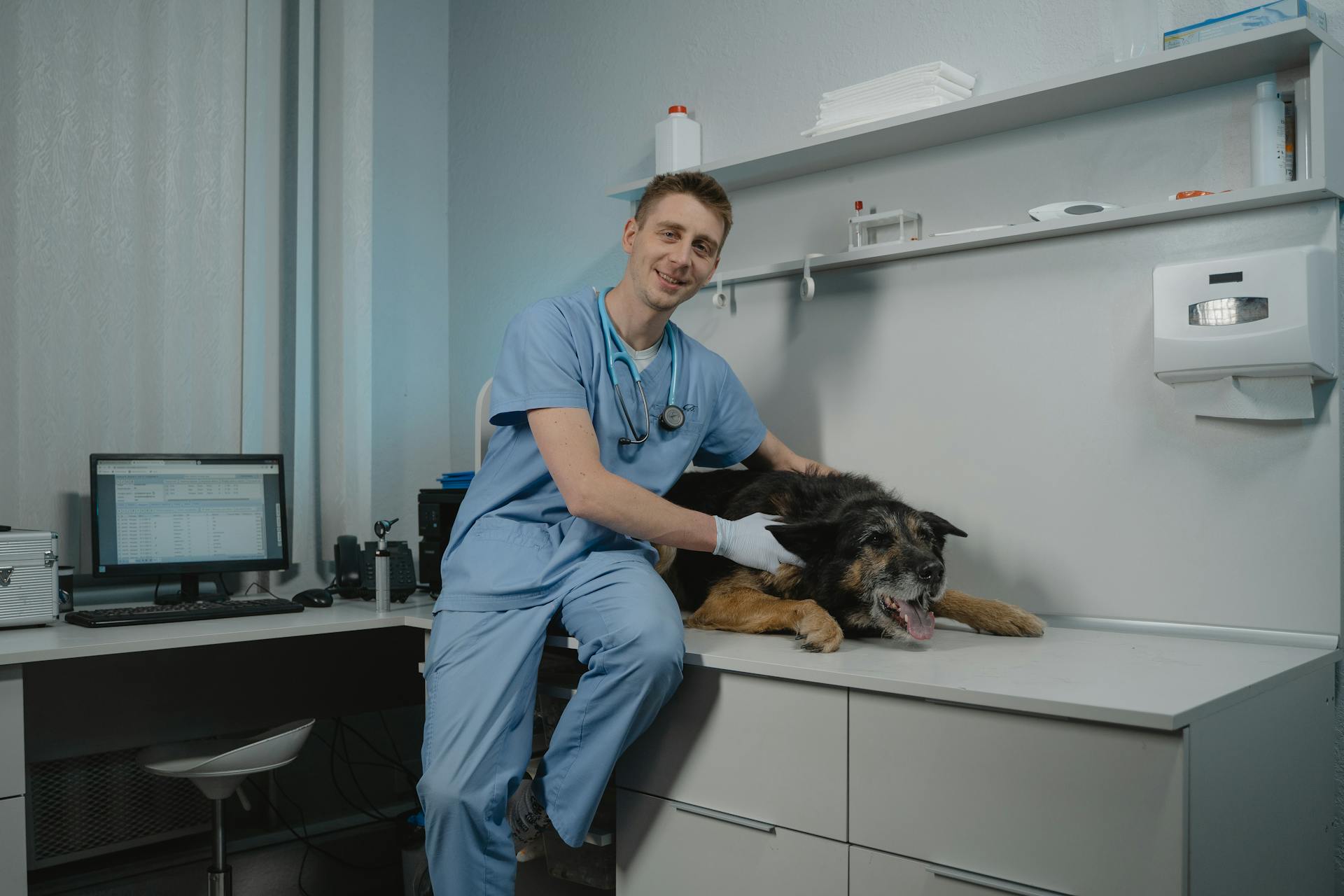
English Bulldog tail amputation is a serious decision that requires careful consideration. This surgery is typically performed to prevent tail injuries, which are common in English Bulldogs due to their short, stubby tails.
English Bulldogs are prone to tail injuries because their tails are extremely short and often get caught in tight spaces or pinched between objects.
The decision to amputate an English Bulldog's tail should not be taken lightly. It's essential to weigh the potential benefits against the risks and consider alternative solutions, such as tail docking.
Is Amputation Necessary?
Amputation may be necessary if your bulldog is experiencing persistent sores and infections in the tail area despite receiving proper care.
Bulldogs with certain tail types, such as inverted tails, corkscrew tails, and deep tail pockets, are more prone to issues compared to those with straight tails.
These tail types can lead to skin folds and moisture accumulation, creating an ideal environment for bacteria and infections to thrive.
If your bulldog's tail is causing more harm than good, consider discussing amputation with your veterinarian to determine the best course of action for your pet's health and well-being.
Recommended read: English Bulldog Tail Types
Health Conditions and Emergency Situations
If a bulldog develops severe infections, injuries, or other complications related to its tail, amputation may become an urgent necessity regardless of the dog's age.
Cleaning the area with hydrogen peroxide and a cotton ball can help heal and prevent sores and inflammation.
You should keep the area dry to prevent any further infection, and antibiotics may also be tried but only under the guidance of a veterinarian.
If the problem persists after applying adequate care, tail amputation might be the only option.
Infection and Injury
Infections in bulldogs' tails can quickly escalate due to poor air circulation and difficulty in maintaining cleanliness in the tail area.
A simple abrasion can become infected if left untreated, leading to more severe systemic health complications.
Severe cases of infection may require amputation to prevent the spread of infection to the bloodstream or other areas of the body.
In some cases, an injury to the tail can disrupt the blood supply, making amputation the only viable option to prevent further complications.
A skilled veterinarian is crucial in assessing each case individually and recommending the best course of action based on the specific circumstances and severity of the condition.
Health Conditions Requiring Early Amputation:
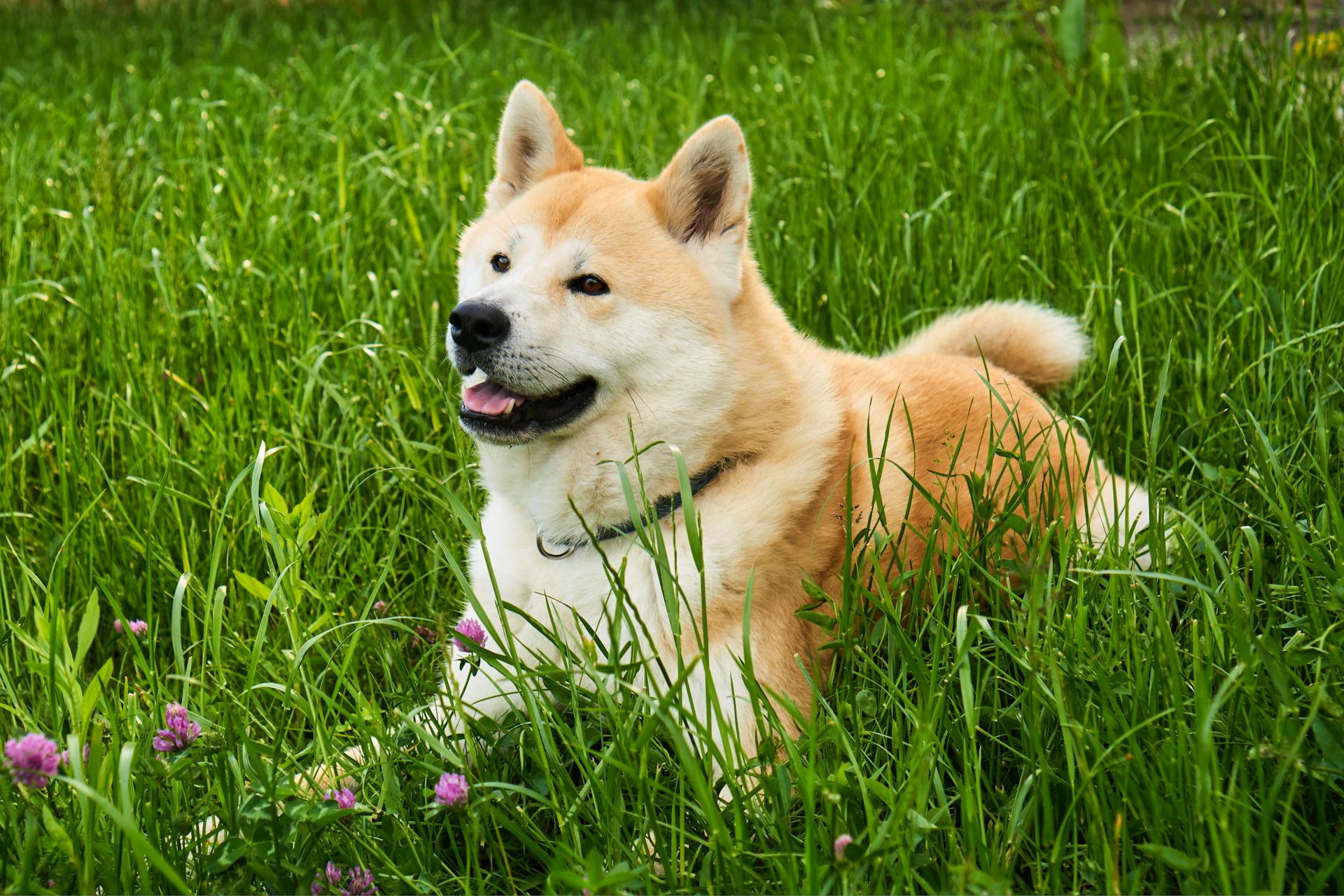
If a bulldog is born with severe genetic predispositions that cause immediate health issues, veterinarians might recommend amputation at a young age. Performing the surgery early can help prevent the development of chronic conditions and improve the puppy's quality of life.
A tightly coiled tail can lead to recurrent infections, severe dermatitis, or difficulty in tail pocket maintenance. This can be prevented with early amputation.
Always make sure to go through precautionary measures first and use hydrogen peroxide to clean the inflamed area and sores. If the issue reoccurs, visit the veterinarian and see if antibiotics can help.
Emergency Conditions:
Emergency Conditions can be life-threatening for bulldogs, and it's crucial to act quickly. If your bulldog develops severe infections, injuries, or complications related to its tail that don't respond to medical treatments, amputation may become necessary.
Cleaning the affected area with hydrogen peroxide and a cotton ball can help prevent sores and inflammation. This simple step can make a big difference in preventing further infection.
If the problem persists after adequate care, your veterinarian may recommend tail amputation. This is usually the last resort, but it's essential to prioritize your bulldog's health and well-being.
The Surgical Procedure and Aftercare
Your Bulldog's surgery wounds will need to be cleaned and dried regularly to prevent infection.
You can expect your pet to feel a bit sluggish a few days after the surgery.
Your veterinarian may prescribe antibiotics, painkillers, and anti-inflammatory meds to help manage your Bulldog's pain and discomfort.
To prevent your Bulldog from biting at the surgery site, an Elizabethan collar will be necessary to wear around their neck.
Your Bulldog's surgery wounds should fully heal in 3 to 4 weeks after the operation.
On a similar theme: English Bulldog Nose Surgery
The Surgical Procedure
Before the surgery, veterinarians will conduct lab tests on your bulldog to determine its fitness for surgery. They apply anesthesia during the surgery, so it’s crucial that your dog is healthy enough to withstand it.
Your veterinarian will administer anesthesia to your dog once the lab test results confirm it's safe to proceed.
The surgeon will determine the point on the tail where he’ll perform the surgery once the anesthesia takes effect.
After the successful procedure, your bulldog will most probably spend the night in the pet hospital.
It’s a common procedure nowadays, and your dog shouldn’t face any difficulties.
A different take: English Bulldog Lab
Post-Amputation Care
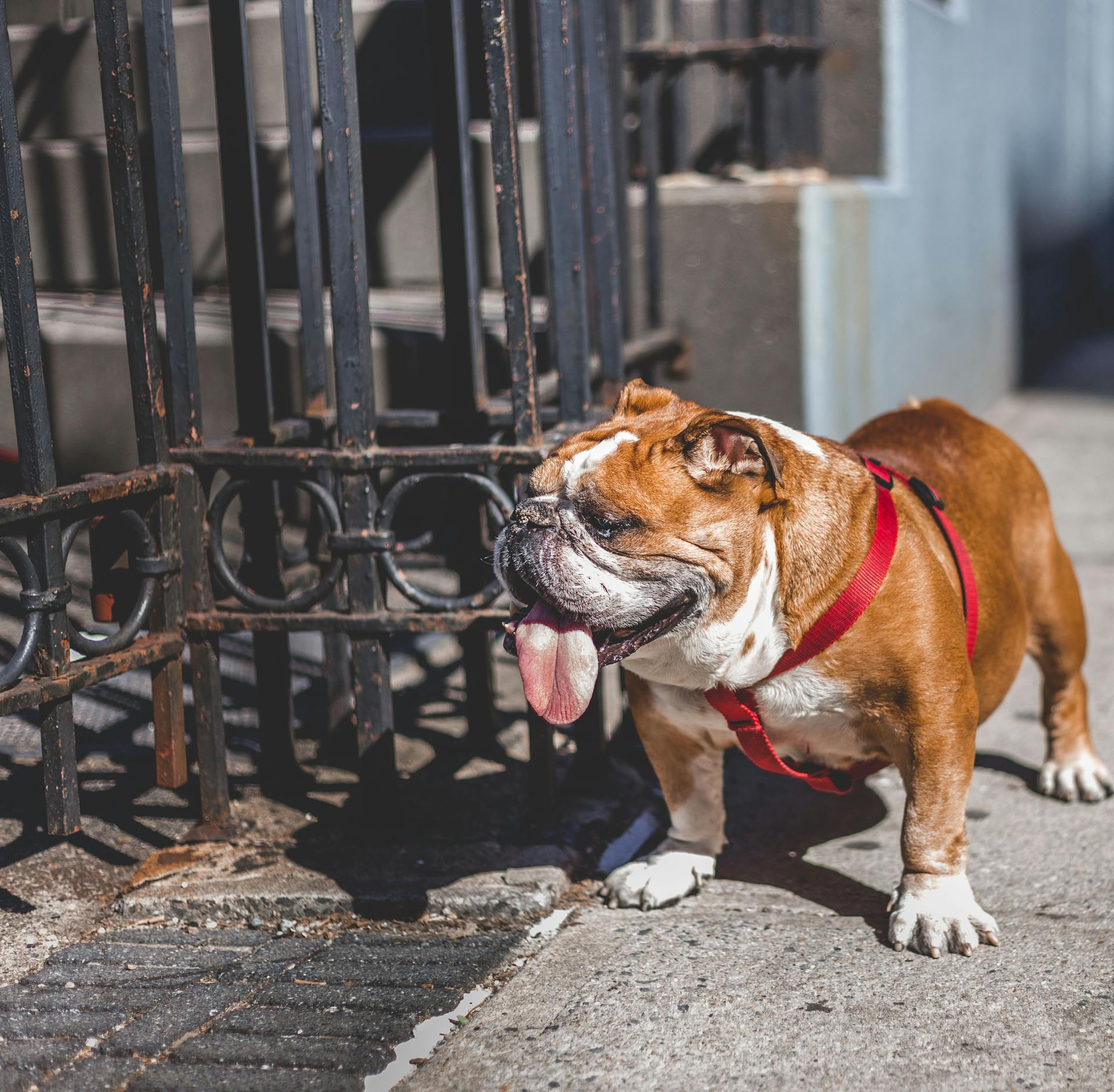
After the surgery, it's essential to clean and dry your Bulldog's surgery wounds to prevent infection.
You'll likely be sent home with a prescription for antibiotics to prevent infection and painkillers to manage your Bulldog's discomfort.
Your Bulldog may feel sluggish a few days after the surgery, so it's crucial to provide a comfortable and safe environment for them to recover.
An Elizabethan collar may be necessary to prevent your Bulldog from biting their tail area, which can lead to further complications.
Surgery wounds should fully heal in 3 to 4 weeks after the operation, but it's essential to follow your veterinarian's instructions for proper care and follow-up appointments.
Recommended read: English Bulldog Cherry Eye Surgery Cost
Surgery for Skinfold and Ears
Surgery for Skinfold and Ears can be a delicate and complex process. Bulldogs often require surgical interventions to address skinfold and ear-related issues.
Tail Amputation may be necessary in severe cases where the tail is causing discomfort or infection. This surgical procedure involves removing the tail to prevent further complications.
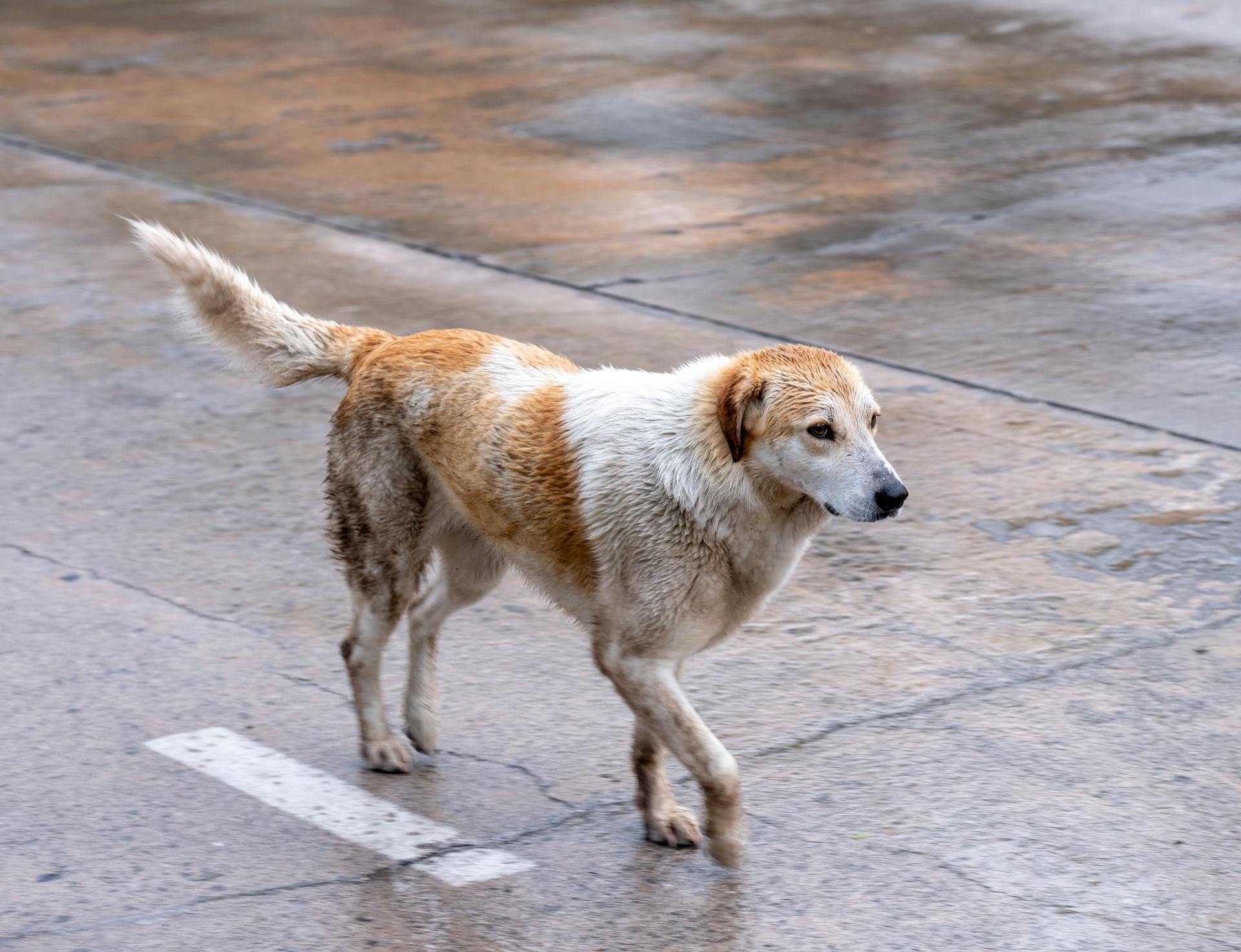
Aural Hematomas Repair is a common surgery for bulldogs with ear problems. This procedure involves repairing the blood vessels in the ear to prevent further bleeding and infection.
TECA end-stage ear resection is a surgical option for bulldogs with severe ear infections or damage. This procedure involves removing the affected ear tissue to prevent further complications.
Mass Removal may be necessary to remove any abnormal growths or tumors on the skin. This surgical procedure involves carefully removing the mass to prevent further growth or infection.
In some cases, Biopsies, Cultures, and Cytology may be performed to diagnose skinfold and ear-related issues. These diagnostic tests involve taking tissue samples or performing cultures to determine the underlying cause of the problem.
Physical and Behavioral Impacts
English Bulldog tail amputation can have both physical and behavioral impacts on your furry friend.
After undergoing the procedure, some bulldogs may experience increased irritability due to the pain or discomfort associated with the surgery.
Providing a quiet, comfortable resting area can help ease your bulldog's transition to life post-amputation.
Physical Health Impacts
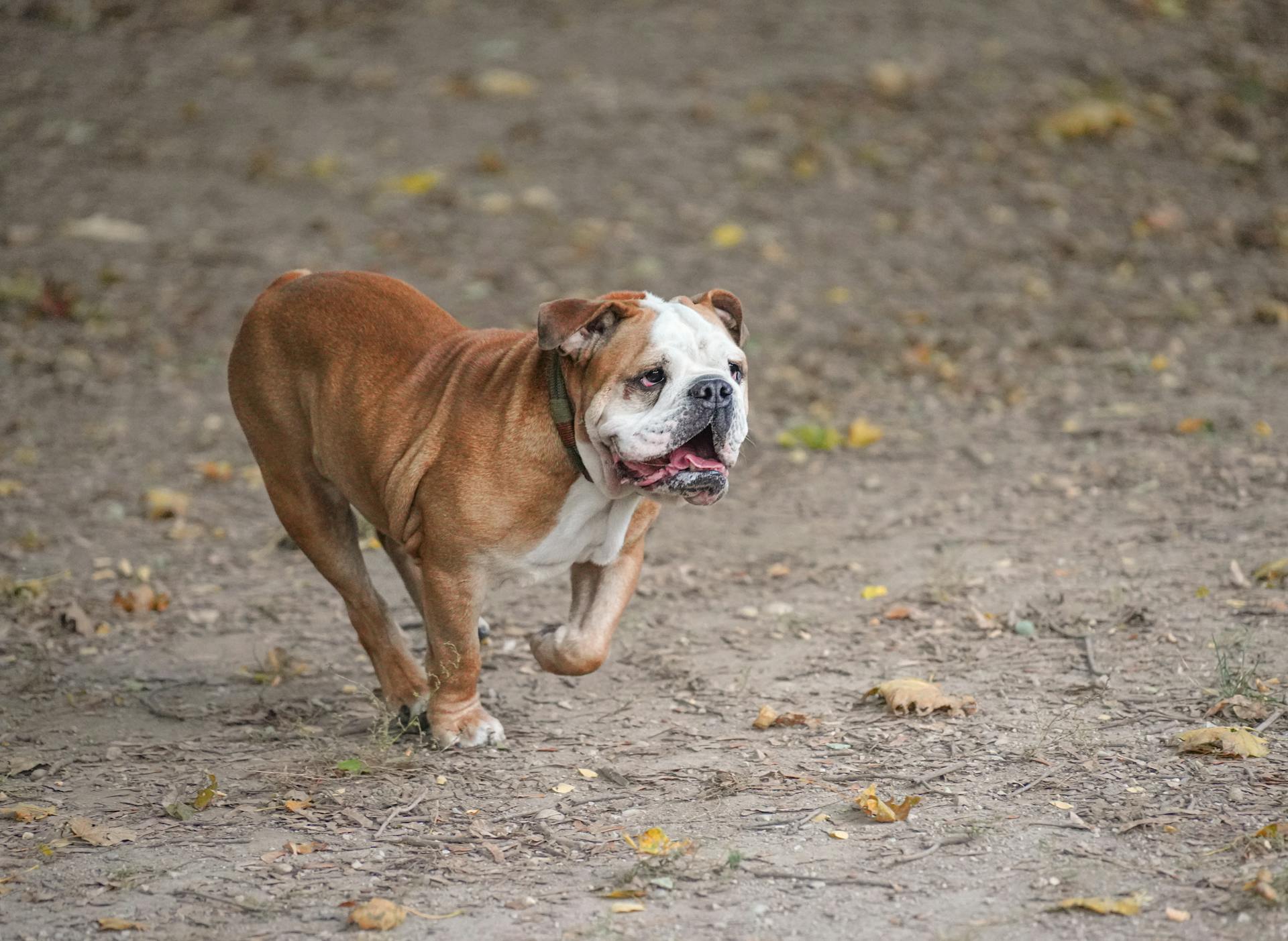
Living with a bulldog that's had a tail amputation can be a bit of an adjustment for both you and your pet. The absence of a tail can significantly affect a bulldog's balance and their ability to communicate with other dogs.
Without a tail, a bulldog might struggle with maintaining stability while moving quickly or making sharp turns. Owners need to be cognizant of these changes and may need to assist their pet in adapting to new ways of mobility and interaction.
Securing slippery floors and providing step-assist tools for furniture can help accommodate a bulldog's altered physical capabilities.
A fresh viewpoint: English Bulldog Insurance
Behavioral Changes
After undergoing an English Bulldog tail amputation, some bulldogs may exhibit behavioral changes due to the pain or discomfort associated with the procedure.
Increased irritability, lethargy, or a decreased interest in play and interaction are all potential reactions you should be aware of.
Providing a quiet, comfortable resting area can help ease your bulldog’s transition to life post-amputation.
Offering gentle reassurance is also crucial during this adjustment period, as it can help your bulldog feel more at ease.
Ethical and Legal Considerations
English bulldog tail amputation raises important ethical concerns. Advocates for the procedure argue it's necessary for the dog's health and well-being, especially in cases of severe infection or injury.
Opponents, on the other hand, view tail amputation as an unnecessary mutilation of the animal. They argue it infringes on the dog's natural physical integrity without its consent.
The decision to amputate should be based on medical necessity, not for cosmetic reasons or convenience. This means considering each case with a focus on the welfare and health needs of the specific animal.
Broaden your view: Common English Bulldog Health Issues
Ethical Considerations
Ethical considerations are a crucial aspect of any decision-making process, especially when it comes to our furry friends.
Bulldog amputation is surrounded by ethical debates, with advocates arguing that it's a necessary intervention for the health and well-being of the dog.
The procedure is often justified when severe infection, injury, or genetic conditions make amputation medically advisable, alleviating pain and preventing further health complications.

However, opponents argue that tail amputation constitutes an unnecessary mutilation of the animal, infringing on the dog's natural physical integrity without their consent.
This perspective is particularly held in situations where the amputation is considered for cosmetic reasons or convenience rather than medical necessity.
Each case of amputation should be considered with a focus on the welfare and health needs of the specific animal.
Legal Status by Region
In some countries, regulations restrict tail amputation to strictly medical conditions, requiring veterinary evidence and justification before the procedure can be legally performed.
These laws aim to prevent unnecessary surgical alterations to animals and promote animal welfare.
The laws in other regions may be less stringent, allowing for tail amputation for non-medical reasons.
Bulldog owners need to be aware of the local regulations and ethical standards regarding tail amputation.
It is essential to ensure that any decision made aligns with both legal requirements and the best interests of the pet.
Alternatives and Timing
A tail amputation may not be the only option for English bulldogs with tail problems.
Some English bulldogs are born with naturally short or "nub" tails, which can be a desirable trait in the breed.
However, surgery is still an option for English bulldogs with severely damaged or painful tails.
Genetic Predispositions
Bulldogs are genetically predisposed to several tail abnormalities that can necessitate amputation.
Their tightly coiled tails can fit tightly against the body, creating a small, enclosed space known as the tail pocket.
This area is prone to moisture accumulation and is difficult to clean, which can lead to bacterial and yeast infections as well as severe dermatitis.
The skin within the tail pocket can become irritated and inflamed, causing discomfort and pain to the dog.
Regular cleaning and medical interventions may fail to improve the condition, making tail amputation a possible solution.
A different take: English Bulldog Infected Tail Pocket
When to Choose Docking?
If your Bulldog is experiencing an infection in the tail area that just won't heal, it's time to consider docking. This is a serious issue that needs professional attention.
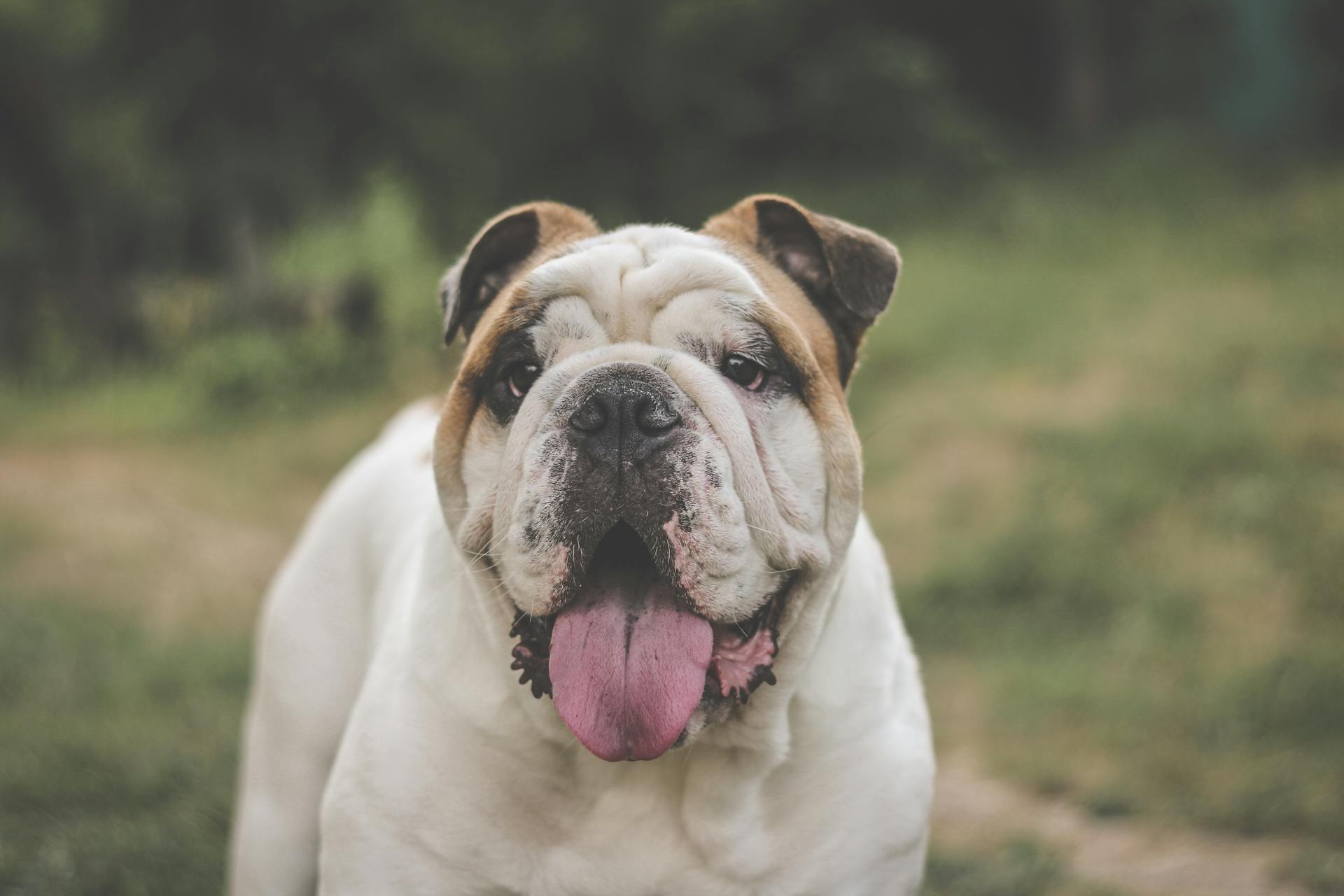
Infection in the tail area can be a sign of a deeper problem, so it's essential to address it promptly. A Bulldog-specialist veterinarian is the best person to consult in this situation.
A deep tail pocket that's impossible to clean and dry thoroughly is another reason to consider docking. This can lead to further infections and health issues.
If your Bulldog's tail is inverted and grows back into the rear, docking may be necessary. This can cause discomfort and pain for your pet.
In all cases, it's crucial to seek the opinion of a Bulldog-specialist veterinarian before opting for docking. They will assess your pet's condition and advise on the best course of action.
Additional reading: Oakland County Pet Adoption Center
Timing Considerations
As a responsible pet owner, you'll want to consider the ideal time for tail amputation in Bulldogs. Bulldogs with corkscrew tails, inverted tails, and deep tail pockets are prone to elimination difficulties.
This is especially true for puppies, who may not be able to fully control their bowel movements due to their tail structure. Tail amputation is usually recommended for puppies with problematic tail structures as soon as possible.

Bulldogs with ideal tail structures, such as straight tails, can often go without tail amputation altogether. However, if your Bulldog is experiencing persistent infection, sores, or inflammation due to their tail, surgery may be necessary.
In some cases, tail amputation may be necessary at an older age, such as when a Bulldog's tail has already caused significant health issues.
Not Something to Worry About
While it might sound scary at first, a tail amputation surgery is a common solution for bulldogs with persistent tail pocket issues. It's not something you should worry about if you've tried other methods to no avail.
In fact, one bulldog owner, Rene Gonzales, adopted his 9-year-old bulldog with a horribly infected tail pocket and decided on amputation after trying everything else. He's now a happy social butterfly.
The surgery can be a game-changer for bulldogs living in discomfort due to tail pocket issues. Brittney W's bulldog, for example, had to have her tail removed due to persistent problems, and she's now much happier.
Consider reading: English Bulldog Soft Palate Surgery

It's worth noting that some bulldogs may require additional surgery, like Eva Marie Lardanis' bulldog, who still experiences bleeding after pooping three years after the initial surgery.
Here are some key points to consider when deciding on tail amputation surgery for your bulldog:
- A tail amputation surgery can be a viable solution for bulldogs with persistent tail pocket issues.
- Some bulldogs may require additional surgery to address related health issues.
- It's essential to consult with a veterinarian to determine the best course of action for your bulldog.
Frequently Asked Questions
What does a screw tail look like?
A screw tail, also known as an ingrown tail, is a corkscrew-like deviation of the tail commonly seen in English bulldogs. It appears as a twisted or curved tail shape.
Sources
- https://english-bulldog.shop/bulldog-tail-amputation-all-you-need-to-know
- https://www.vetscalpel.com/case-studies/bulldog-tail-fold-co2-laser-caudectomy/
- https://www.bulldogsworld.com/health-and-medical/tail-amputation
- https://vet4bulldog.com/dr-kraemer-medical-surgical-services/
- https://bulldogguide.com/bulldog-tail-amputation/
Featured Images: pexels.com


